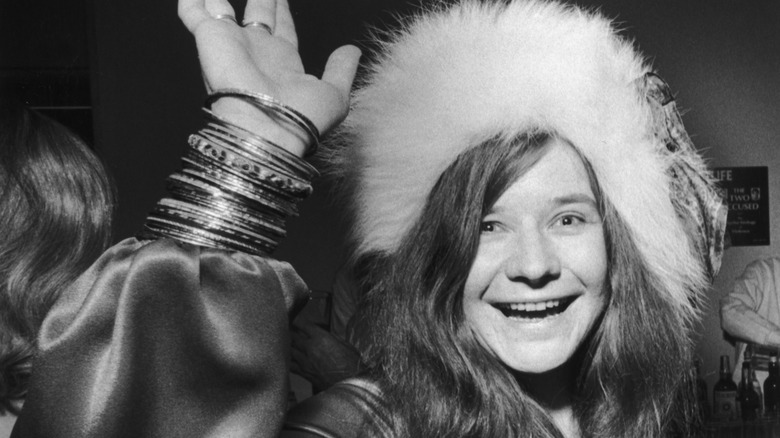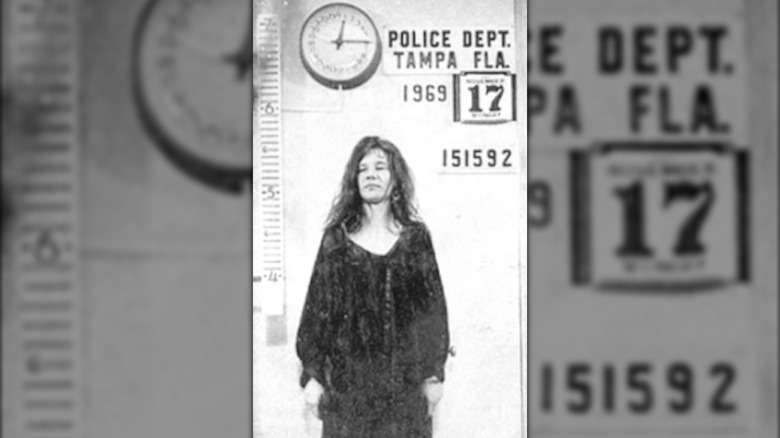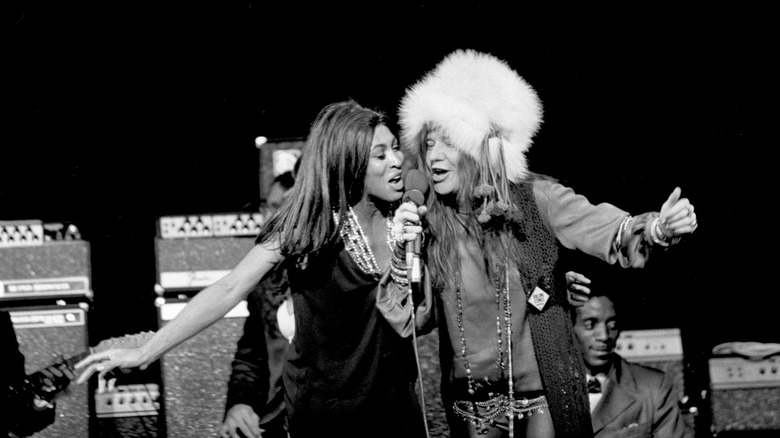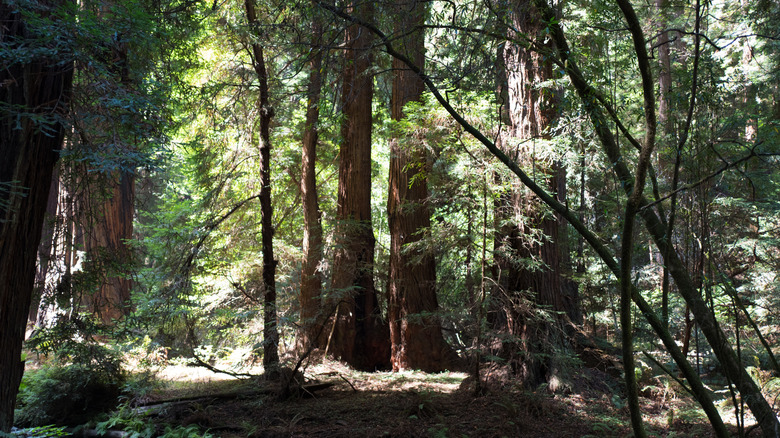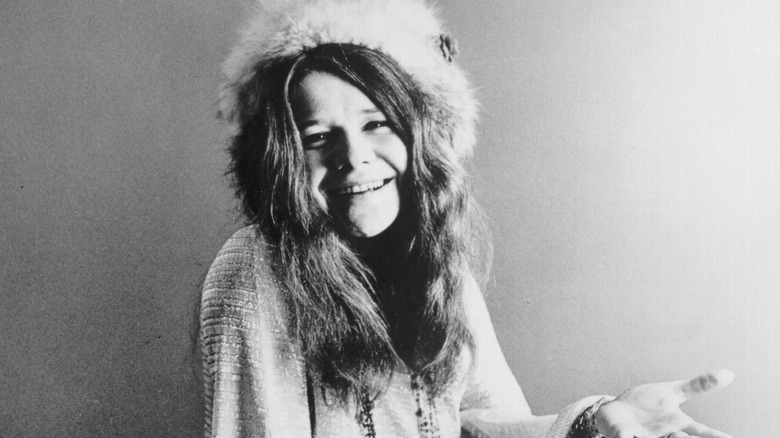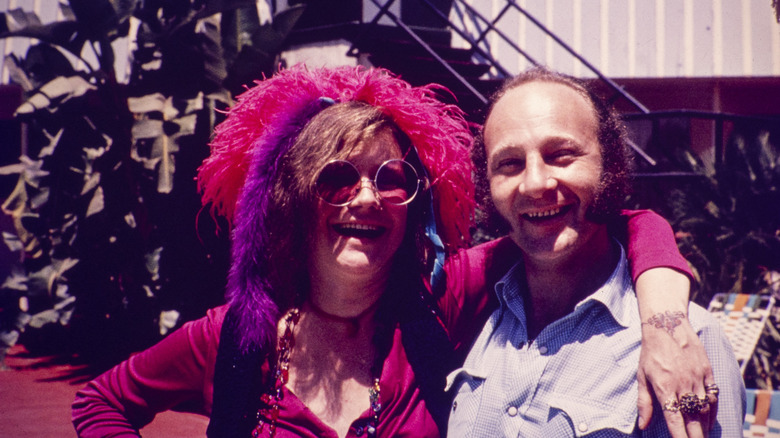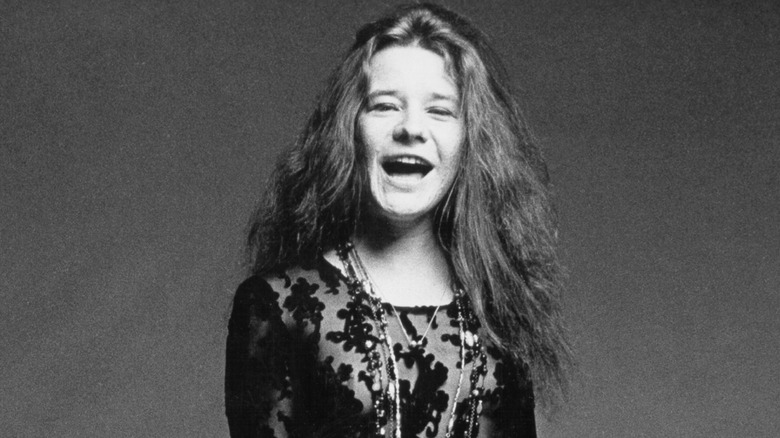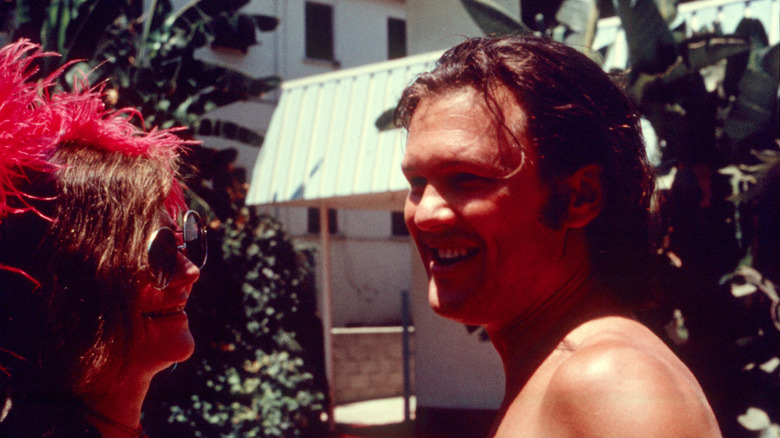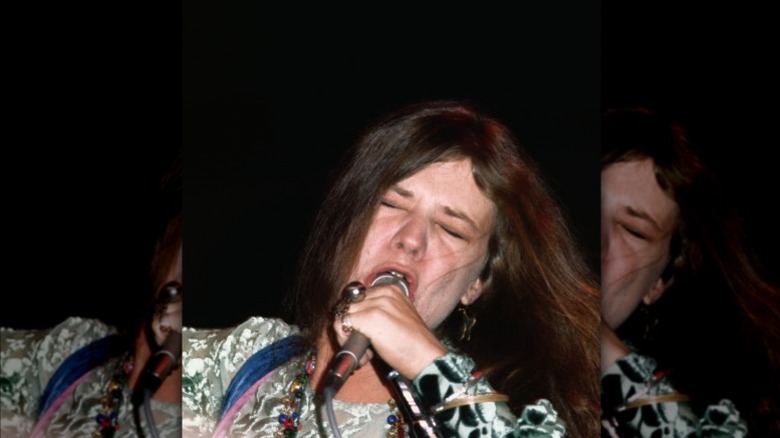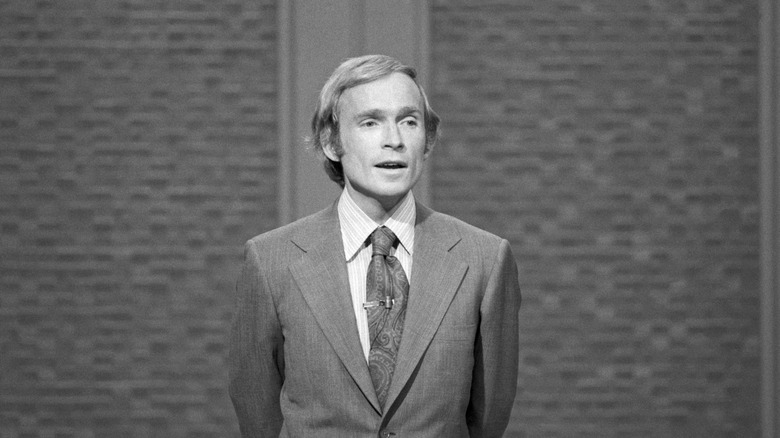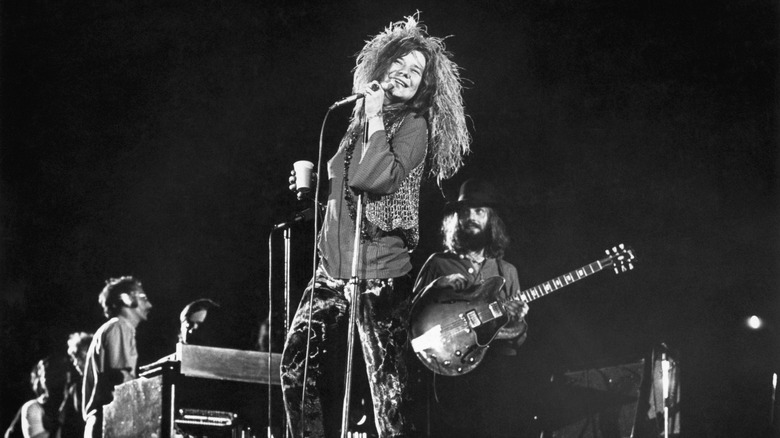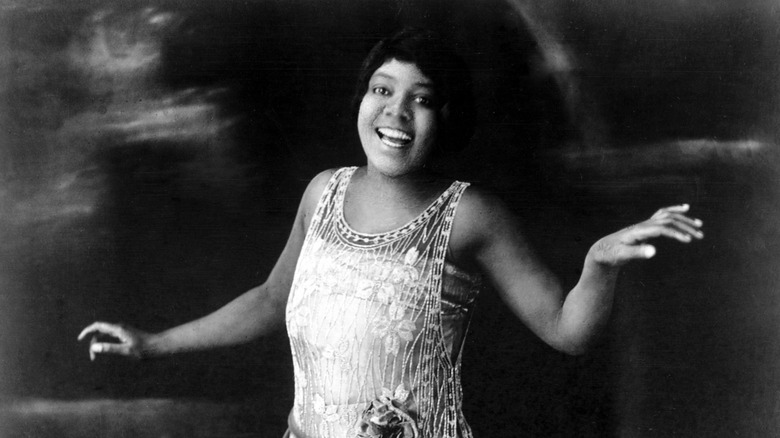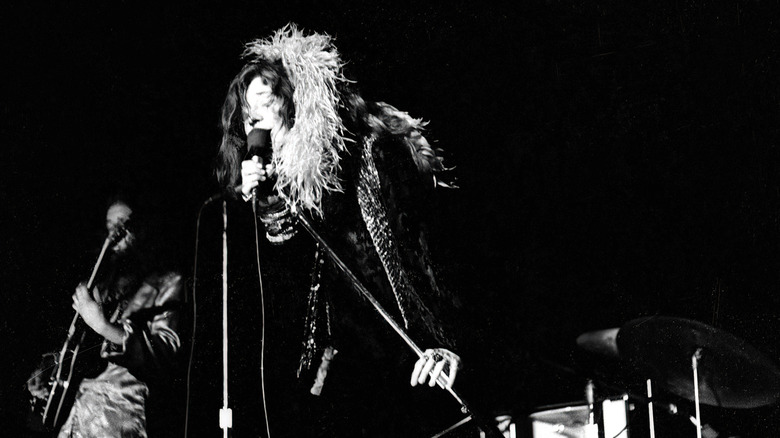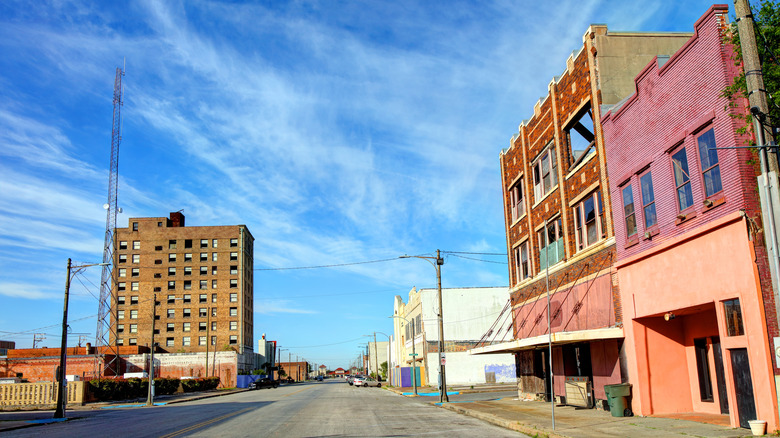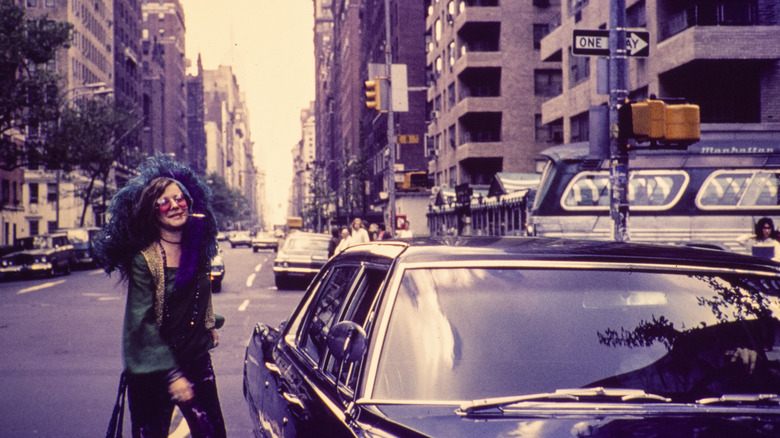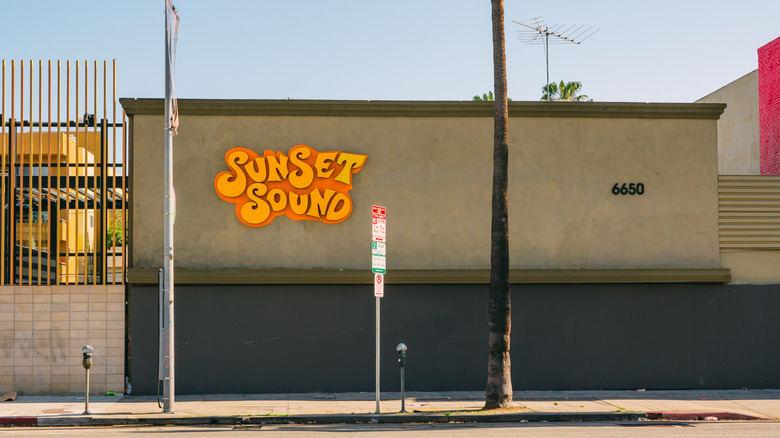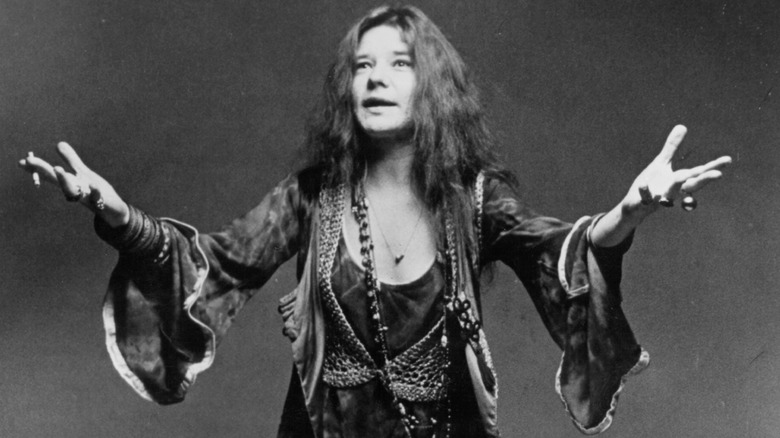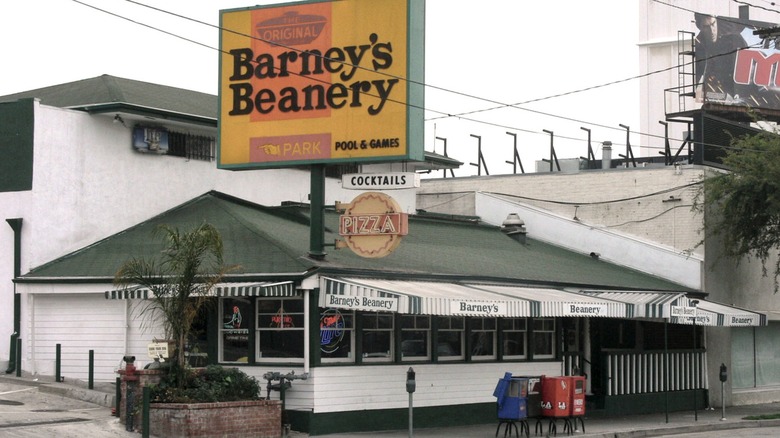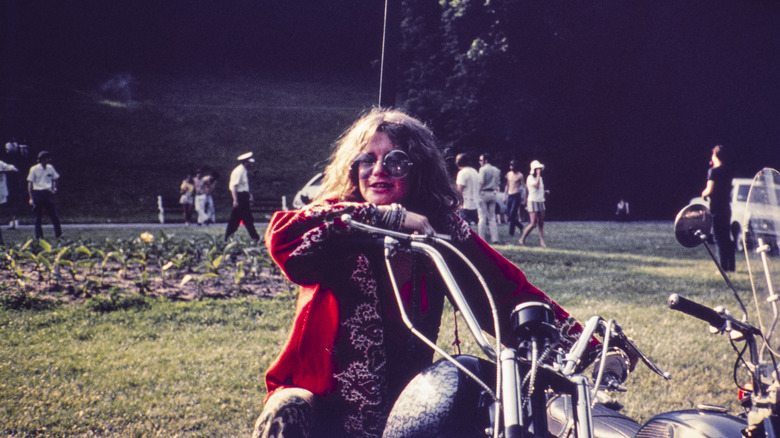What The Final Year Of Janis Joplin's Life Was Like
Janis Joplin is remembered today as rock and roll royalty. While her talent and stage presence had plenty to do with this, the fact that she tragically became a member of the infamous "27 Club" — the alleged inordinate number of celebrities who died at the age of 27 — cemented her legacy for generations to come.
The future star had humble beginnings. She was born on January 19, 1943, in Port Arthur, Texas, where she embraced the hippie lifestyle and did not fit in with her peers. Eventually, she moved to San Francisco and got involved in the '60s music scene. She landed the job of lead singer for Big Brother & the Holding Company in 1966. From there, while addiction, depression, and music industry drama were constant problems, she became a huge success.
It all came to an abrupt end, only four years after it had begun, when Janis Joplin died on October 4, 1970. Here's what the final year of her life was like.
This article contains multiple references to drug and alcohol misuse. If you or anyone you know needs help with addiction issues, help is available. Visit the Substance Abuse and Mental Health Services Administration website or contact SAMHSA's National Helpline at 1-800-662-HELP (4357).
Janis Joplin was arrested for profanity
Janis Joplin was riding high after her star turn performing at Woodstock on August 17, 1969. Even though she was quite drunk during her early-morning set, she gave a brilliant performance that won her even more fans. She continued doing shows regularly in the months after the iconic festival, and her fans flocked to see her.
She probably didn't expect that almost exactly three months after Woodstock, she would be leaving a gig in handcuffs. The reason Janis Joplin was once arrested is very rock 'n' roll, but also seems silly in this day and age. On November 16, 1969, Joplin was playing a concert in Tampa, Florida, for 3,500 people. At one point, attendees began dancing in the aisles and on their chairs. The police who were doing security for the venue began pushing the crowd back and told Joplin to instruct her fans to get back in their seats. She refused. "Don't f*** with those people," she said. This was followed by more profanity, and she taunted the cops for not paying to see her perform like her fans had. After the show, Joplin was arrested for using "vulgar and indecent language." She spent about an hour at the police station being booked, then left in a fur coat like the rock star she was.
The charges were eventually dropped by a judge who determined that Joplin's use of profanity was protected free speech. In 2004, her mugshot was sold by the auction house Christie's for $3,346.
Janis Joplin had beef with the Rolling Stones
Janis Joplin was no fan of the Rolling Stones, at least according to her friend Mark Farner. He told Rock History Music, "We would sit and have this conversation. [She'd say,] 'British invasion, my ass. Those guys sing in American English because we are the only ones free. Those guys are born subject to the crown; those guys are born a******s!'" But it seems Joplin took her dislike a bit further than just talking trash behind the Brits' backs. Farner claims, "We spoke of this, and she was smearing chocolate all over the seats of a helicopter that the Rolling Stones were going to use next."
Joplin may have thought Mick Jagger was fake for singing in an American accent, but that didn't stop her from attending the Rolling Stones concert at Madison Square Garden on November 27, 1969 (her fellow future member of the "27 Club" Jimi Hendrix was also in the audience). The band's opening act was Ike and Tina Turner. Joplin, who as usual had a few drinks in her, decided to jump up onstage right at the end of their set to sing and dance with Turner.
Despite Joplin's "performance" being off-key and only lasting for a few seconds, the audience loved it. Her appearance was also notable enough to be featured in much of the concert's media coverage. The Stones, on the other hand, were not happy and made it clear to Joplin that it had better never happen again.
She tried to put down roots
Some claim there was a philosophy Janis Joplin lived by, which was to "get stoned, stay happy, and have a good time." However, in a 1969 letter to her friend Linda Gravenites, Joplin made it clear that this was only half of the complete thought. Recalling how the pair had talked before about how to battle depression (which the rock star called the "Kozmic Blues"), Joplin said one way was to get stoned and have a good time, while the other was "to try and adjust to it" (via "Janis: Her Life and Music"). A year before she died, Joplin was ready to try the second option.
Tired from two years of constant touring, Joplin bought a house in a wooded, suburban area outside of San Francisco in August of 1969 and spent the next year trying to make it a home. While modest by today's rock star standards, Joplin added her own touches, including painting the walls purple, installing a huge doggy door for her St. Bernard, and bringing in a pool table. She sat on the back porch, cooking on the built-in barbeque and looking out on redwood trees and a stream. She hoped that the location's beauty, quiet, and calm would help her stay off drugs.
Trying to convince Gravenites to move in with her, Joplin wrote, "The excitement of having a house and the incredible peace you feel there ought to be wonderful. We could really be happy there."
She managed to get clean
Janis Joplin had been using and abusing drugs since long before she was famous, of both the illegal variety and those prescribed by her doctor. She also drank heavily, but it was her use of heroin that really concerned those around her.
Despite writing to her friend Linda Gravenites that the new home she bought would be a peaceful place to help her stay off drugs, when Gravenites moved in during November 1969, she realized Joplin was still using. An intervention followed, and Joplin saw a specialist for help in December, but it was clear she wasn't ready to give it up just yet. Just 10 days after seeking treatment, she accepted heroin offered to her backstage at one of her concerts.
Even so, Joplin knew her drinking and drug habit was getting out of hand. Chicago's James Pankow says that Joplin liked hanging out with that band before shows because they would encourage her to drink less before going on stage. What finally allowed her to give up heroin for four to five months during her final year was a trip she took to Brazil in February 1970. Originally arriving to attend Carnival (where she was kicked out of her hotel for skinny dipping in the pool), Joplin ended up staying longer and hitchhiking around the country. Somehow, this was the rehab she needed, and it worked. She came back to the United States clean and stayed that way for several months.
She had relationships with men and women
People who attended a Janis Joplin concert often describe the experience as subtly, or even overtly, sexual. On stage, Joplin came alive in a way that was sensual and intimate. Once the performance was over, however, she was a woman insecure about her looks who wanted to get married and have kids one day. However, she still embraced the free love vibe of the hippie movement.
She was rumored to have been intimate with Jim Morrison and Jimi Hendrix, but in her final year, she had several other flings and relationships. Some of the famous men included football star Joe Namath and musician Kris Kristofferson, but she also dated regular guys. She met fellow American David Niehaus on a beach in Brazil in February 1970. He had no idea who she was, an increasingly rare experience for her, and they began a relationship. She even got engaged to a young college dropout named Seth Morgan the month before she died.
One major question about Joplin is how to define her sexuality. In 1973, her friend Peggy Caserta published a memoir in which she claimed to have been Joplin's lover up until her death. However, in her later years, Caserta explained that she didn't actually write the book and blamed the ghostwriter for adding the stuff about their relationship. Caserta said she only went along with it because she needed money for drugs. Regardless of what Joplin and Caserta's relationship really was, Caserta believed Joplin was bisexual.
Janis Joplin invented an alter-ego
The raucous version of Janis Joplin who performed on stage drunk was not her natural personality, but a persona she adopted for her career. The dichotomy between her real self and who she became onstage was something that messed with her brain. She told one interviewer, "I used to wonder — especially when people would clap and tell me I was good — I used to wonder ... Is it really me or am I putting on a show?" (via "A Bad Woman Feeling Good: Blues and the Women Who Sing Them").
As she became famous and "Janis Joplin" became synonymous with that image, she tried to break from that persona in her private life by asking people to call her Pearl. There is a bit of disagreement from sources and acquaintances about how and when this happened. It may have started in the last year of her life, as the journalist Al Aronowitz, on his website The Blacklisted Journalist, recalled that the last thing she ever said to him, at a concert on August 6, 1970, was not to call her Janis anymore: "I'm sick and tired of it. Call me Pearl."
Others say the nickname came much earlier, during her years in San Francisco in the mid-1960s. Even more confusingly, Joplin biographer Myra Freeman wrote that it was actually Pearl who was the over-the-top onstage persona, while Janis was the real person offstage, although Joplin's own comments seem to refute this.
She went on a three-week bender
Janis Joplin's only No.1 hit was "Me and Bobby McGee," released posthumously. It was a cover of a Kris Kristofferson song, and when Joplin met him in early 1970, they formed an immediate connection. With some other friends, the couple embarked on a three-week drinking session that became known as "The Great Tequila Boogie." Joplin was off heroin at the time, but the group was perpetually drunk. Kristofferson said, "I dug her, but I had itchy feet. I'd get up intending to get out, and in she comes with the early morning drinks and pretty soon you're wasted enough and you don't care about leaving" (via Far Out).
The drinking spree ended with an infamous tattoo party. Joplin had recently gotten inked on her wrist at Lyle Tuttle's tattoo parlor in San Francisco. She liked her new decoration so much that she had him come out to her house and tattoo her friends and bandmates. Although the exact number of people who received tattoos during the party is uncertain, it may have been as many as 18. It certainly did a lot to popularize tattoos, especially among women. Joplin got a second tattoo at the party, a small heart on her chest. She would later tell Dick Cavett (and the nation) on his show that the one on her wrist was for everyone and the heart was just for her friends.
It was only some imminent tour dates that brought The Great Tequila Boogie to an end.
Janis Joplin continued to tour relentlessly
After playing a show at Madison Square Garden on December 19, 1969, Janis Joplin took a break from performing. For three months, she did little else but spend time with her good friend and roommate, Linda Gravenites, at their home outside of San Francisco, trying to find peace.
But for a rock star at the peak of her fame, she couldn't be away from her fans any longer. In early 1970, Joplin went back on the road with a new backing band, the Full Tilt Boogie Band. Among the various gigs and surprise performances she undertook, Joplin also joined The Grateful Dead on their "Festival Express" tour across Canada, headlining with other huge acts including The Band. Joplin seemed to have a wonderful time. According to at least one person involved, the musicians on the tour were able to enjoy the shows for the music more than at most concerts and festivals, where the enjoyment was often geared towards the fans. In Toronto, Joplin told the crowd, "Man, I never expected this of Toronto. You're really looking beautiful, man" (via Heritage Ontario).
Audiences loved Joplin just as much in Canada as in the United States. One reviewer wrote about the steep $16 price of admission to one of the shows, "it was worth that much and more to see and hear Janis Joplin sing with the insistence and power of a pile-driver and generate enough personal electricity to light up a stadium all by herself."
Janis Joplin made her final TV appearance
Even back in the 1960s, stars had to sell their brand and promote their work. In much the same way they do today, this could involve going on late-night talk shows hosted by Jack Parr or Johnny Carson or Dick Cavett. Despite her brash, hippie manner and his cerebral, buttoned-up personality, Janis Joplin and Cavett were friends, and he had her on his popular talk show numerous times. He would later credit her with helping make his show, which first aired in 1968, a hit with viewers. Joplin, who normally disliked doing TV, would tell people that Cavett was the exception.
So it was fitting that Janis Joplin's final interview on television was with her good friend. On August 3, 1970, she gave what would be both her final TV performance and TV interview. While Cavett has admitted that listening to what his guests were saying could be difficult, he seemed to genuinely enjoy chatting with Joplin, whom he called his "little songbird." Their free-wheeling conversation covered everything from her songwriting process (or lack thereof), to her recent trip to Brazil, to her upcoming high school reunion, to her tattoos – and that barely scratches the surface of the topics the pair managed to discuss. Joplin also performed the song "Move Over."
Cavett remembered Joplin fondly decades later. He attended the premiere of the documentary "Janis: Little Girl Blue" in 2015, where he regaled other guests with stories about his late friend.
She reunited with her old band at the Festival for Peace
One of the most notable performances Janis Joplin gave during the final year of her life was at the "Festival for Peace." Organized by Peter Yarrow of Peter, Paul, and Mary, it fell on the 25th anniversary of the U.S. dropping the atomic bomb on Hiroshima. The lineup was one for the ages. Over the course of 12 hours, the festival-goers enjoyed performances from the likes of Steppenwolf, Creedence Clearwater Revival, Paul Simon (controversially performing without Art Garfunkel for the first time), Miles Davis, Dionne Warwick, and many more.
Held at Shea Stadium on August 6, Janis Joplin was a last-minute addition to the lineup, joining her former band Big Brother & the Holding Company on stage to close the festival. Three days before, Joplin had announced she would be there during her final interview on "The Dick Cavett Show." But three days was not enough time to make up for the inadequate publicity the event had generated before then. Despite hoping for a crowd of 30,000-50,000 people, only an estimated 15,000 tickets were sold. The proceeds went to anti-war organizations.
Regardless of the disappointing crowd size, Joplin put on an electric show, including a duet with Dionne Warwick. The Village Voice review of the concert stated that Joplin's performance was "a dynamite surprise appearance that started such rhythmic foot-stamping from the crowd that the stands were vibrating a full five or six inches with every beat."
Janis Joplin bought a headstone for one of her biggest influences
Janis Joplin was aware that she owed her sound to Black blues singers who came before her. She was open about her influences and credited their greatness. So it was fitting that she went some way to paying back one of her biggest influences in an unexpected way: Janis Joplin bought a headstone for Bessie Smith.
Smith was an overnight sensation in 1923 when she recorded her first record. By the end of the 1920s, she had made more money than any other Black entertainer in history. But due to changing tastes, her star faded in the 1930s. Tragically, she had finally begun a career comeback when, on September 26, 1937, she was a passenger in a car driven by her partner that was involved in a horrific accident with a truck. Badly injured, including losing her arm, Smith died at the hospital. Her exact age is unknown, but she was probably in her early 40s. While 7,000 people attended her funeral near Philadelphia, her family didn't have enough money to afford a headstone.
The blues singer's grave remained unmarked for decades, until a letter to The Philadelphia Inquirer asking about it caught the public's attention. On August 7, 1970, a stone purchased by Joplin and NAACP leader Juanita Green (who had known Smith in the 1930s), was unveiled in Mount Lawn Cemetery. It reads, "The Greatest Blues Singer in the World Will Never Stop Singing."
Janis Joplin's final concert
On August 12, 1970, Joplin's and the Full Tilt Boogie Band gave what would be her last public performance in Boston at Harvard Stadium. An estimated 40,000 people showed up to see her ... and then were forced to wait for hours for the show to start. It seemed that some of the sound equipment had been stolen, and when new amps finally arrived, the techs had to set everything up again. Two opening acts were only just enough to keep the fans from rioting, according to people who were there.
Kevin McElroy was in attendance and told WBUR that while the crowd was waiting for the concert to finally start, he could see "Janis was underneath [the stage]. And she had a bottle of Southern Comfort, and she was just in a world of her own there. She just was doing what she wanted to do in the moment. After another hour-and-a-half or so — it was really quite a delay — she literally burst onto the stage. It was just electric."
Journalist Charles Giuliano was there as well and reviewed the concert for the Boston Herald Traveler. Between his review and his memories, it is clear that Joplin was not looking great, visibly inebriated and unhealthy, and getting out of breath by the middle of songs. Still, she gave the performance her all, bantering with the audience and making up lyrics when she forgot the real ones. She never performed live again.
Janis Joplin attended her high school reunion
During her final TV interview on "The Dick Cavett Show" on August 3, 1970, Janis Joplin made a shocking announcement. Despite having a horrible time in high school, where she was bullied for being different, Joplin announced on TV that she would attend her 10-year reunion on August 14. She told Cavett, "They laughed me out of class, out of town, and out of the state — so I'm going home" (via YouTube).
This could have been a triumphant return, considering she was a huge rock star by that point. But when reporters cornered her at the event, the reality of how painful it was for her became obvious. Captured on video are all her awkward movements and angry retorts to rude questions from the journalists about why she had been bullied and not asked to the prom. Her only plaudit from her class was the award for traveling the furthest to attend.
Her younger sister, Laura Joplin, was still living in Port Arthur and attended the reunion with Janis. Laura told Louder that while the footage looks awkward, overall the experience was a good thing: "I think that Janis got what she needed from it. She resolved some of her questions of her place relative to high school people and whether or not she needed to be applauded. It wasn't the wonderful triumph she would have loved, some huge, red-carpet honor from her high school. The perspective just wasn't at Port Arthur yet."
She had a whirlwind romance
Sometime in the summer of 1970, 21-year-old Seth Morgan delivered cocaine to Janis Joplin's house. He was the son of a wealthy New York literary family, but had dropped out of UC Berkeley and gotten involved in the drug trade. Joplin toured over the summer, but when she returned to California in August, the pair started dating. Morgan moved into her home, and by September, they were engaged. Morgan's former lawyer told The Washington Post, "He fell in love with her because she was a star. ... Every time I saw them, they were wrapped up in each other, [but] they had mutual doubts about each other's fidelity."
"Everybody wanted to know what Janis saw in me," Morgan told the Los Angeles Times in 1990, shortly before his death in a motorcycle crash at age 41. While they had only known each other for a matter of weeks, Morgan says that the rock star was serious about marrying him. He claimed that the final call Joplin made before she died was to city hall asking about getting a marriage license for the couple. "She wanted us to get married on a cruise ship," he said.
Those close to Joplin, including her sister Laura and one of her bandmates, think she was just looking for marriage and a possible retirement (or at least a break) from the music industry as an escape. Morgan wasn't perfect, but he was there.
She recorded her final album
In the weeks before she died, Janis Joplin was working hard on her next album at the Sunset Sound recording studio in Los Angeles. There was a lot of pressure on her to deliver, since it was her second solo album and her first one had not performed as well commercially as the ones where she was part of Big Brother & the Holding Company. She recorded songs including "Move Over" (which she had performed during her final TV appearance) and "Me and Bobby McGee" (which had led to her relationship with its writer, Kris Kristofferson).
There was another song Joplin recorded during one of her final sessions that wasn't meant for the album: a birthday message for John Lennon. The former Beatle told the story a year later on "The Dick Cavett Show." Lennon said, "We didn't meet, but she sent me a birthday tape on my birthday for my last birthday. Yoko asked all different people to make a tape for me, and she was one of them, and we got it after she died. It arrived in the post, and she was singing happy birthday to me in the studio" (via Far Out).
The last song Janis Joplin ever recorded was "Mercedes Benz." She did it in one take. It was October 1, 1970, and her penultimate session in the studio before her death three days later. The album she was working on would be posthumously released as the rock and roll classic "Pearl."
She relapsed on heroin
Janis Joplin was committed to being at her best during the "Pearl" recording sessions, but this dedication may have inadvertently contributed to her death. Joplin had been off heroin for several months at that point, ever since she returned from her trip to Brazil in the spring. Not using any substance at all was clearly not an option for her, so she had been drinking heavily over the summer. But she knew that drinking was bad for her voice, and hangovers would make her less with it in the studio. She decided the best thing to do was to stop drinking and start using heroin again.
The singer told herself that this was just a temporary solution, and that she would give it up again when recording was over and she could return to booze. She would wait until the recording session was done for the day and then do a small hit. Whether or not Joplin would have been able to get clean one more time is something the world will never know. Her tolerance for the drug was lower since she had not been using it for a while, and the drugs she was getting were, unbeknownst to the singer, much stronger and purer than what she had been using previously.
All of these things would form a perfect storm that would end up killing the singer long before her time.
Janis Joplin's final day was typical
Janis Joplin's last full day alive was October 3, 1970. If there was any feeling of impending doom, it wasn't obvious from the normal way she spent it. Most of her day was spent at the Sunset Sound recording studio. Her backing group, the Full Tilt Boogie Band, had finished the instrumental track for the song "Buried Alive in the Blues." Joplin was planning to record her vocals for it the next day, so she listened to the instrumental in preparation.
It was 11 p.m. by the time Joplin left the studio. She headed to Barney's Beanery, where she had some drinks with a couple of her band members. Then she returned to her hotel alone. No one was waiting for her, which was unexpected. She had asked both her fiancé Seth Morgan, and her friend Peggy Caserta to join her. Neither showed up. Morgan hadn't bothered to get on the flight down from San Francisco, where he was entertaining other women in Joplin's house that evening.
Joplin injected heroin in her room. Because of the technique she preferred, the drug hit her system more slowly. While she waited, she went downstairs to get cigarettes. The last person she spoke to was the hotel's receptionist, when she asked for change so she could use the cigarette machine. Then Joplin returned to her room and was never seen alive again.
Janis Joplin was found dead in her hotel room
The tragic death of Janis Joplin occurred in room 105 of the Landmark Hotel in Los Angeles sometime after midnight on October 4, 1970. The next day, the singer failed to show up at the studio to record as planned, so her producer called Janis' road manager, John Cooke, to find out where she was. Seth Morgan was also trying to get a hold of his fiancée, and called Cooke when she didn't answer the phone.
It was 18 hours after her death when Cooke went to the Landmark Hotel. There, her body was discovered on the floor of her room. Cooke would later describe it as looking like a crime scene, because there was blood from where Janis had hit her head when she collapsed. The coroner ruled that the singer died of an accidental heroin overdose. She was 27.
Her younger sister, Laura Joplin, would later reveal that while Janis always got her heroin from a drug dealer she trusted, the chemist he used to test each batch was unavailable that day. The heroin Janis took was 10 times more powerful than normal. Laura told Louder, "There's certainly a lesson in her life for me. It's important to be true to yourself, as she said many times, and at the same time — what she didn't quite get as clearly — to realize that you have to live with the consequences of your behavior. And she died from them."
